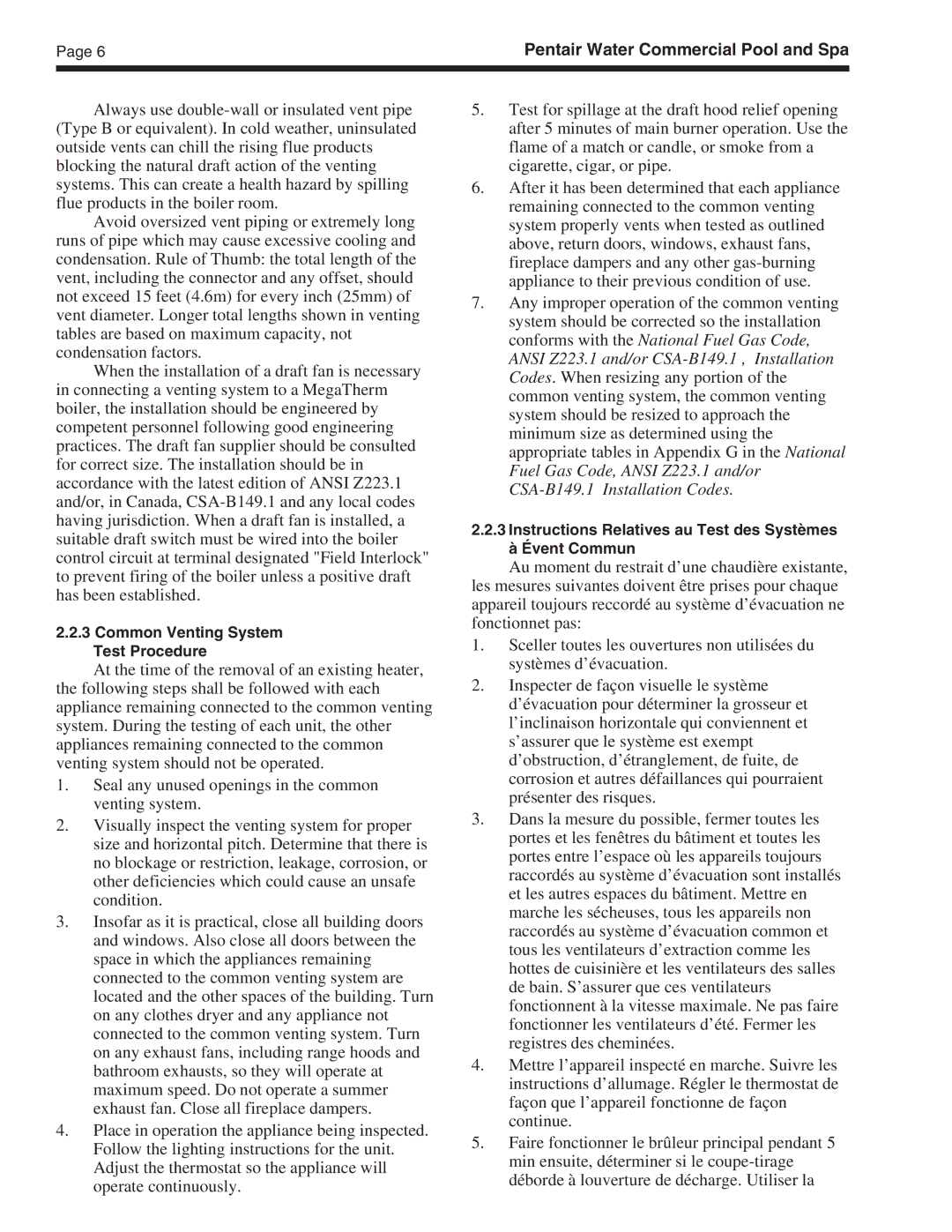Page 6 | Pentair Water Commercial Pool and Spa |
|
|
|
|
Always use
Avoid oversized vent piping or extremely long runs of pipe which may cause excessive cooling and condensation. Rule of Thumb: the total length of the vent, including the connector and any offset, should not exceed 15 feet (4.6m) for every inch (25mm) of vent diameter. Longer total lengths shown in venting tables are based on maximum capacity, not condensation factors.
When the installation of a draft fan is necessary in connecting a venting system to a MegaTherm boiler, the installation should be engineered by competent personnel following good engineering practices. The draft fan supplier should be consulted for correct size. The installation should be in accordance with the latest edition of ANSI Z223.1 and/or, in Canada,
2.2.3Common Venting System Test Procedure
At the time of the removal of an existing heater, the following steps shall be followed with each appliance remaining connected to the common venting system. During the testing of each unit, the other appliances remaining connected to the common venting system should not be operated.
1.Seal any unused openings in the common venting system.
2.Visually inspect the venting system for proper size and horizontal pitch. Determine that there is no blockage or restriction, leakage, corrosion, or other deficiencies which could cause an unsafe condition.
3.Insofar as it is practical, close all building doors and windows. Also close all doors between the space in which the appliances remaining connected to the common venting system are located and the other spaces of the building. Turn on any clothes dryer and any appliance not connected to the common venting system. Turn on any exhaust fans, including range hoods and bathroom exhausts, so they will operate at maximum speed. Do not operate a summer exhaust fan. Close all fireplace dampers.
4.Place in operation the appliance being inspected. Follow the lighting instructions for the unit. Adjust the thermostat so the appliance will operate continuously.
5.Test for spillage at the draft hood relief opening after 5 minutes of main burner operation. Use the flame of a match or candle, or smoke from a cigarette, cigar, or pipe.
6.After it has been determined that each appliance remaining connected to the common venting system properly vents when tested as outlined above, return doors, windows, exhaust fans, fireplace dampers and any other
7.Any improper operation of the common venting system should be corrected so the installation conforms with the National Fuel Gas Code, ANSI Z223.1 and/or
2.2.3Instructions Relatives au Test des Systèmes à Évent Commun
Au moment du restrait d’une chaudière existante, les mesures suivantes doivent être prises pour chaque appareil toujours reccordé au système d’évacuation ne fonctionnet pas:
1.Sceller toutes les ouvertures non utilisées du systèmes d’évacuation.
2.Inspecter de façon visuelle le système d’évacuation pour déterminer la grosseur et l’inclinaison horizontale qui conviennent et s’assurer que le système est exempt d’obstruction, d’étranglement, de fuite, de corrosion et autres défaillances qui pourraient présenter des risques.
3.Dans la mesure du possible, fermer toutes les portes et les fenêtres du bâtiment et toutes les portes entre l’espace où les appareils toujours raccordés au système d’évacuation sont installés et les autres espaces du bâtiment. Mettre en marche les sécheuses, tous les appareils non raccordés au système d’évacuation common et tous les ventilateurs d’extraction comme les hottes de cuisinière et les ventilateurs des salles de bain. S’assurer que ces ventilateurs fonctionnent à la vitesse maximale. Ne pas faire fonctionner les ventilateurs d’été. Fermer les registres des cheminées.
4.Mettre l’appareil inspecté en marche. Suivre les instructions d’allumage. Régler le thermostat de façon que l’appareil fonctionne de façon continue.
5.Faire fonctionner le brûleur principal pendant 5 min ensuite, déterminer si le
